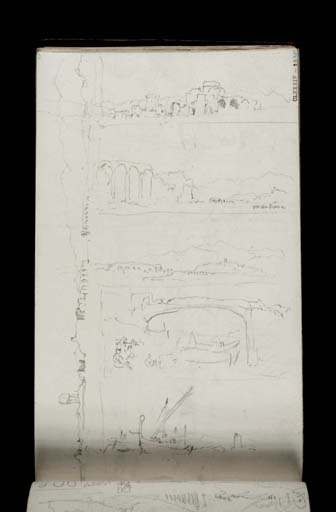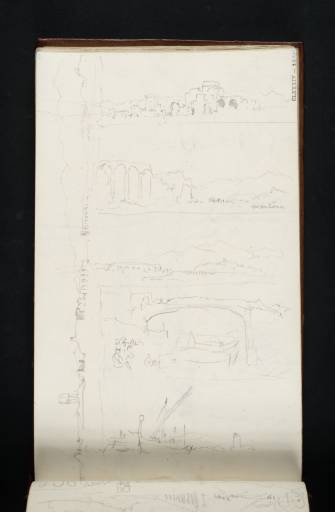Joseph Mallord William Turner Four Views of the Roman Remains of Minturnae; and Two Sketches of the Ferry over the Garigliano River 1819
Image 1 of 2
-
 Joseph Mallord William Turner, Four Views of the Roman Remains of Minturnae; and Two Sketches of the Ferry over the Garigliano River 1819
Joseph Mallord William Turner, Four Views of the Roman Remains of Minturnae; and Two Sketches of the Ferry over the Garigliano River 1819 -
 Joseph Mallord William Turner, Four Views of the Roman Remains of Minturnae; and Two Sketches of the Ferry over the Garigliano River 1819 (Enhanced image)Enhanced image
Joseph Mallord William Turner, Four Views of the Roman Remains of Minturnae; and Two Sketches of the Ferry over the Garigliano River 1819 (Enhanced image)Enhanced image
Joseph Mallord William Turner,
Four Views of the Roman Remains of Minturnae; and Two Sketches of the Ferry over the Garigliano River
1819
Joseph Mallord William Turner 1775–1851
Folio 31 Recto:
Four Views of the Roman Remains of Minturnae; and Two Sketches of the Ferry over the Garigliano River 1819
D15615
Turner Bequest CLXXXIV 30
Turner Bequest CLXXXIV 30
Pencil on white wove paper, 197 x 122 mm
Inscribed by the artist in pencil ‘Minturna’ bottom right of second sketch from top
Inscribed by ?John Ruskin in blue ink ‘281’ top right, ascending right-hand edge and ‘30’ top left, ascending left-hand edge
Stamped in black ‘CLXXXIV 30’ top right, ascending right-hand edge
Inscribed by ?John Ruskin in blue ink ‘281’ top right, ascending right-hand edge and ‘30’ top left, ascending left-hand edge
Stamped in black ‘CLXXXIV 30’ top right, ascending right-hand edge
Accepted by the nation as part of the Turner Bequest 1856
References
1909
A.J. Finberg, A Complete Inventory of the Drawings of the Turner Bequest, London 1909, vol.I, p.543, as ‘Several sketches of do. [the aqueducts of Minturnus]’.
1984
Cecilia Powell, ‘Turner on Classic Ground: His Visits to Central and Southern Italy and Related Paintings and Drawings’, unpublished Ph.D thesis, Courtauld Institute of Art, University of London 1984, p.179 notes 40 and 41.
1987
Cecilia Powell, Turner in the South: Rome, Naples, Florence, New Haven and London 1987, p.79 notes 33 and 34.
This page contains several related sketches of views seen from the point where the Via Appia meets the Garigliano river (also known as the Liris). The three uppermost vistas, as well as the study running parallel with the left-hand edge, all depict the remains of the ancient Roman settlement of Minturnae, near the Garigliano ferry. These include a section of ruined aqueduct, and part of a theatre or amphitheatre (the latter of which is now almost completely demolished). The modern town of Minturno can also be seen in the distance silhouetted on a hill against the backdrop of the Arunci mountains. The remaining two studies represent views of the river and the ferry crossing.1
The landscape in this part of Italy was described by Revd John Chetwode Eustace in A Classical Tour Through Italy (first published 1813):
The road runs over a fine plain, bordered on the left by distant mountains; and on the right by the sea. About three miles from the Liris (Garigliano) [river] an aqueduct, erected to convey water to Minturnae, passes the road; it is now in ruins, but the remaining arches, at least a hundred, lofty and solid, give a melancholy magnificence to the plain which they seem to bestride. On the banks of the Liris and to the right of the road extend the ruins of Minturnae, spread over a considerable space of ground, exhibiting substructions, arches, gateways, and shattered walls, now utterly forsaken by human inhabitants ... The delay occasioned by the ferry affords the traveller time enough to range over the site and the remains of Minturnae.2
Turner made notes from this section of Eustace’s publication in the Italian Guide Book sketchbook (Tate D13954; Turner Bequest CLXXII 12a). As the passage suggests, the artist seems to have had enough time whilst waiting for the Garigliano ferry to make several swift studies. Further views of the Roman remains can be found on folio 30 verso (D15614; Turner Bequest CLXXXIV 29a), whilst other sketches of the ferry can be seen on folio 31 verso (D15616; Turner Bequest CLXXXIV 30a).
Nicola Moorby
April 2010
Compare the tower visible in the bottom view with a watercolour by John Robert Cozens (1752–97), Near the Mouth of the Garigliano (British Museum, London), reproduced in colour in Giuliano Briganti, Nicola Spinosa and Lindsay Stainton, In the Shadow of Vesuvius: Views of Naples from Baroque to Romanticism 1631–1830, exhibition catalogue, Accademia Italiana delle Arti e delle Arti Applicate, London 1990, p.68, top.
How to cite
Nicola Moorby, ‘Four Views of the Roman Remains of Minturnae; and Two Sketches of the Ferry over the Garigliano River 1819 by Joseph Mallord William Turner’, catalogue entry, April 2010, in David Blayney Brown (ed.), J.M.W. Turner: Sketchbooks, Drawings and Watercolours, Tate Research Publication, December 2012, https://www

